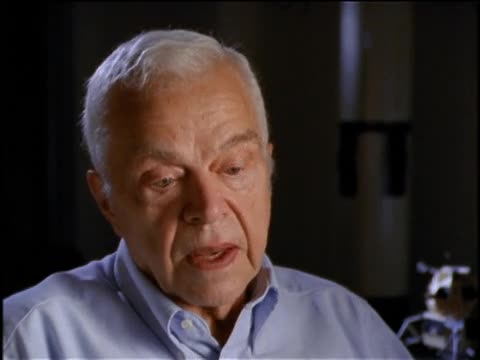NOVA; To the Moon; Interview with John Cornelius Houbolt, aerospace engineer behind the Lunar Orbit Rendezvous (LOR), part 2 of 4
- Series
- NOVA
- Episode
- To the Moon
- Producing Organization
- WGBH Educational Foundation
- Contributing Organization
- WGBH (Boston, Massachusetts)
- AAPB ID
- cpb-aacip-15-m901z4351f
If you have more information about this item than what is given here, or if you have concerns about this record, we want to know! Contact us, indicating the AAPB ID (cpb-aacip-15-m901z4351f).
- Description
- Program Description
- This remarkably crafted program covers the full range of participants in the Apollo project, from the scientists and engineers who promoted bold ideas about the nature of the Moon and how to get there, to the young geologists who chose the landing sites and helped train the crews, to the astronauts who actually went - not once or twice, but six times, each to a more demanding and interesting location on the Moon's surface. "To The Moon" includes unprecedented footage, rare interviews, and presents a magnificent overview of the history of man and the Moon. To the Moon aired as NOVA episode 2610 in 1999.
- Raw Footage Description
- John Cornelius Houbolt, aerospace engineer behind the Lunar Orbit Rendezvous (LOR) is interviewed about the LOR. Houbolt explains the effect of rocket thrusters on the weight of a spacecraft, and Houbolt uses a chart to explain the differences in weight between LOR and direct descent. He also details his campaign to get the LOR accepted by NASA, and Werner von Braun's championing of the LOR, and how LOR saved the US government at least 25 Billion dollars. Houbolt explains Gemini as a "stepping-stone to the moon" by proving rendezvous was feasible and showed that men could do long spaceflight. According to him, LOR was essential to getting men on the moon, and ends with a description of how long it took him to fight for LOR and a conversation on not getting a $100K prize from NASA, but also relates the reaction in the Mission Operations Control Room (MOCR) to Apollo 11's landing on the moon, and von Braun's thanks.
- Created Date
- 1998
- Asset type
- Raw Footage
- Genres
- Interview
- Topics
- History
- Technology
- Science
- Subjects
- American History; Gemini; apollo; moon; Space; astronaut
- Media type
- Moving Image
- Duration
- 00:20:06
- Credits
-
-
Interviewee: Houbolt, John Cornelius, 1919-2014
Interviewee: Houbolt, John Cornelius, 1919-2014
Producing Organization: WGBH Educational Foundation
- AAPB Contributor Holdings
-
WGBH
Identifier: cpb-aacip-4144cb79c88 (Filename)
Format: Digital Betacam
Generation: Original
Duration: 0:20:06
If you have a copy of this asset and would like us to add it to our catalog, please contact us.
- Citations
- Chicago: “NOVA; To the Moon; Interview with John Cornelius Houbolt, aerospace engineer behind the Lunar Orbit Rendezvous (LOR), part 2 of 4 ,” 1998, WGBH, American Archive of Public Broadcasting (GBH and the Library of Congress), Boston, MA and Washington, DC, accessed December 5, 2025, http://americanarchive.org/catalog/cpb-aacip-15-m901z4351f.
- MLA: “NOVA; To the Moon; Interview with John Cornelius Houbolt, aerospace engineer behind the Lunar Orbit Rendezvous (LOR), part 2 of 4 .” 1998. WGBH, American Archive of Public Broadcasting (GBH and the Library of Congress), Boston, MA and Washington, DC. Web. December 5, 2025. <http://americanarchive.org/catalog/cpb-aacip-15-m901z4351f>.
- APA: NOVA; To the Moon; Interview with John Cornelius Houbolt, aerospace engineer behind the Lunar Orbit Rendezvous (LOR), part 2 of 4 . Boston, MA: WGBH, American Archive of Public Broadcasting (GBH and the Library of Congress), Boston, MA and Washington, DC. Retrieved from http://americanarchive.org/catalog/cpb-aacip-15-m901z4351f
